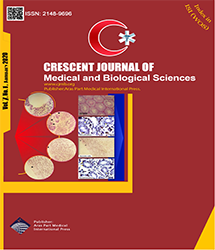
| Original Article | |
| Prevalence and Predictors of Left Ventricle Regional Wall Motion Abnormality 6 Weeks After Primary Percutaneous Intervention in Patients With First Acute Anterior Myocardial Infarction | |
| Sakine Hadi1, Mehrnoush Toufan Tabrizi1, Ahmad Separham1, Mohammadreza Hoseinalizade1, Marzie Sadeghi1, Raziye Parizad1 | |
| 1Department of Cardiology, Shahid Madani Hospital, Tabriz University of Medical Sciences, Tabriz, Iran | |
|
CJMB 2020; 7: 116–123 Viewed : 5326 times Downloaded : 4053 times. Keywords : Myocardial infarction, Primary PCI, RWMA, WMSI |
|
| Full Text(PDF) | Related Articles | |
| Abstract | |
Objectives:Regional wall motion abnormality (RWMA) occurs after acute myocardial infarction (AMI) or primary percutaneous coronary intervention (PPCI). The current study aimed to assess the prevalence of RWMA after PPCI and to defne its baseline clinical, angiographic, and echocardiographic predictors in patients with acute anterior MI. Materials and Methods: Totally, 107 patients (85 males and 22 females with a mean age of 58.21±11.64 years) with frst anterior MI treated with PPCI were evaluated, and transthoracic echocardiographic examination was performed at the admission time and after at least 6 weeks. The RWMA was assessed and wall motion score index (WMSI) was calculated by dividing the sum of the wall motion score over the number of visualized segments. Results: The results revealed no statistically signifcant association between the symptom-onset-balloon time and door-balloon time compared with the WMSI value (P=0.29, r=0.105 & P=0.53, r=-0.062). Regarding post-PPCI thrombolysis in MI (TIMI) flow grades, patients with a grade II and III TIMI flow had a mean WMSI value of 1.90±0.39 and 1.65±0.31, respectively, that was signifcantly higher in patients with a grade II TIMI flow (P=0.002). During the follow-up echocardiography, 84 (79.2%) patients had a positive RWMA and the follow-up positive RWMA was signifcantly lower (7.4%) in patients with stable angina (P=0.01). Statistically noticeable improvements were reported in the level of WMSI and E/E’ ratio during the follow-up period of echocardiography. In addition, there was a signifcant relationship between pre- and post-PCI left ventricular end-systolic volume (LVESV) and WMSI compared with post-PCI RWMA (P=0.03, P<0.0001; P=0.007, P<0.0001). However, no statistically signifcant differences were observed in demographic data and MI risk factors considering the incidence of RWMA and the mean value of WMSI. Conclusions: In patients with the frst acute MI, higher WMS index and LVESV level were strongly related to RWMA incidence after six weeks which could be applied as the predictor factors of RWMA incidence. |
Cite By, Google Scholar
Google Scholar
PubMed
Online Submission System
 CJMB ENDNOTE ® Style
CJMB ENDNOTE ® Style
 Tutorials
Tutorials
 Publication Charge
Medical and Biological Research Center
About Journal
Publication Charge
Medical and Biological Research Center
About Journal
Aras Part Medical International Press Editor-in-Chief
Arash Khaki
Deputy Editor
Zafer Akan


















